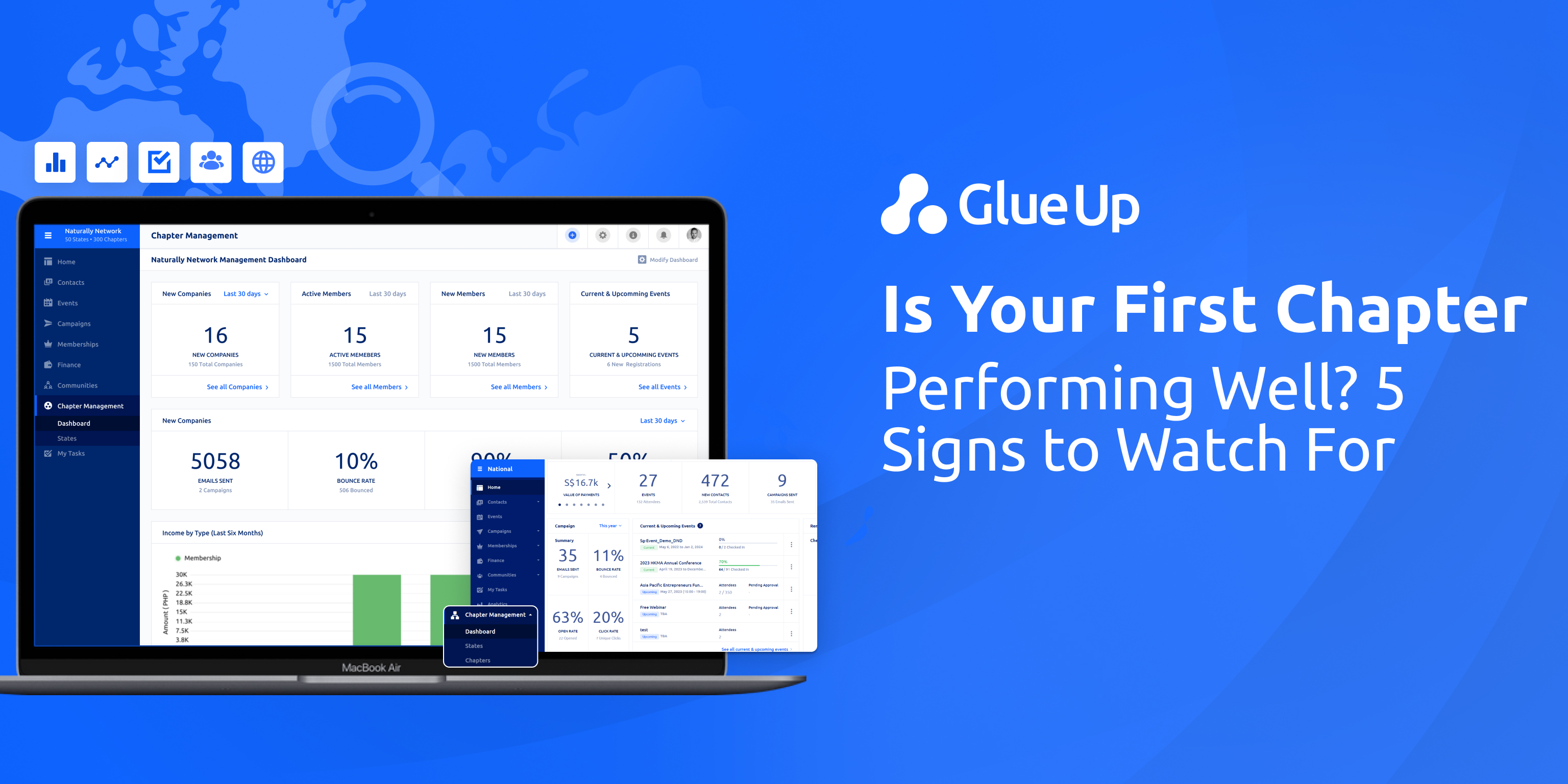
It’s a familiar story for leaders of associations and multi-chapter organizations: the headquarters is running smoothly, the board is aligned on strategic goals, and budgets are signed off. But beneath the surface, the real test of your long-term success lies in whether your chapters are thriving or struggling. Your first chapter—often the proving ground for new members—can either become the launchpad for growth or the silent drain on resources and credibility.
That’s where chapter performance indicators come in. They’re not vanity metrics or endless spreadsheets no one reads. They’re the leading and lagging signals that show whether a chapter is creating real value, retaining members, generating revenue, and aligning with the larger mission. In a business world where every marketing team talks about customer KPIs, net promoter scores, or gross profit margin, it’s easy to forget that associations operate with their own, equally demanding metrics. For multi-chapter organizations, those metrics are existential.
The question is not whether you need chapter performance indicators. The question is whether you have the right ones, tracked consistently, benchmarked fairly, and used in real time to uncover potential issues before they spiral.
Key Takeaways
Chapter performance indicators are essential for multi-chapter organizations because they provide a data driven way to evaluate chapter health, allocate resources wisely, and align chapters with long-term business goals.
The five critical categories of KPIs to track are: membership, engagement, financial, operational, and impact metrics—together they give a full picture of chapter success.
Top chapter performance indicators include retention rate, net membership growth, market penetration, Net Promoter Score, dues realization rate, non-dues revenue mix, leadership pipeline depth, and community impact.
Fair benchmarking matters. Normalize KPIs by size, use per-member rates, and compare within peer groups to ensure smaller and larger chapters are measured equitably.
Regular reviews are non-negotiable. Monitor monthly for operational signals, quarterly for trends, and annually for strategic benchmarking to catch potential issues before they become crises.
Why Performance Indicators Are Critical for Multi Chapter Organizations
Chapters are the frontline of your organization. They are the first point of contact for new members, the hubs of local networking, and the venues for events that drive engagement. If chapters underperform, it shows up everywhere: member retention declines, advocacy weakens, revenue generated falls short, and long-term growth gets compromised.
Here’s the hard truth: most headquarters lack consistent visibility into chapter health. A recent benchmarking study found that while recruitment and retention data are often available, much else—engagement, finances, leadership pipelines—is fragmented or anecdotal. That gap leaves HQ flying blind when it comes to choosing where to allocate resources or how to support chapters strategically.
Performance indicators solve that. They act as a common language between headquarters and local leaders. Instead of emotional debates or gut feelings, you can point to a KPI report and see whether a chapter is aligned with business goals. And because KPIs are data driven, they don’t just describe what’s happening—they reveal why and what might happen next.
For multi-chapter organizations, that’s not just important. It’s survival.
What Are Chapter Performance Indicators
Think of chapter performance indicators as the balanced scorecard of association life, translated to the local level. They are the carefully chosen metrics that show whether a chapter is achieving its strategic goals in areas that matter most: membership, engagement, finance, operations, and impact.
Unlike a gross profit margin in a corporate P&L, chapter indicators don’t just measure dollars. They measure relationships. They measure belonging. They measure whether members feel their dues are worth it and whether sponsors believe their investment generates value.
Some indicators are leading (pointing to future performance): things like event participation rates, leadership pipeline strength, or digital engagement. Others are lagging (showing outcomes after the fact): retention rates, net profit margin, or advocacy wins. Both matter. Without leading indicators, you can’t spot problems early. Without lagging ones, you can’t prove success.
The beauty of performance indicators is that they turn abstract concepts like “member engagement” or “chapter health” into specific business measures that you can benchmark, review, and improve.
Key Chapter Performance Indicators to Track
Not all KPIs are created equal. You need to choose KPIs that reflect both short-term activity and long-term impact. Below are the five categories every multi-chapter organization should monitor.
Membership Metrics
Net Membership Growth: Joins minus lapses divided by starting members. Growth isn’t just a vanity number—it signals momentum.
Retention Rate: Renewed members divided by those eligible to renew. Retention is your most powerful lagging indicator of value delivered.
Market Penetration: Members compared to the total eligible market in a locality. This normalizes for size and lets you compare chapters fairly.
Engagement Metrics
Active Participation Rate: Percentage of members who attend at least one event per quarter.
Event Participation per Member: Are events drawing wide involvement or just the same small group?
Net Promoter Score (NPS): A customer satisfaction measure that asks if members would recommend the chapter. A powerful leading indicator of loyalty.
Financial Metrics
Dues Realization Rate: Collected dues compared to dues billed. A low rate signals structural issues.
Non-Dues Revenue Mix: Sponsorship, event revenue, advertising, and education as a percentage of total revenue. Healthy chapters diversify beyond dues.
Cost to Serve per Member: Operating costs divided by members. This ties to concepts like gross profit margin and net profit margin, showing whether the chapter is sustainable.
Operational Metrics
On-Time Reporting: Percentage of required reports submitted on deadline.
Data Completeness: How many member profiles are fully updated in the management software. Incomplete data undermines strategy.
Leadership Pipeline Depth: Number of qualified candidates per leadership role, plus training completion rates. Without this, a chapter risks collapse.
Impact Metrics
Advocacy Activity: Meetings with policymakers, testimony submissions, lobbying wins.
Community Reach: Non-members who engage in events or partnerships.
Program Outcomes: Certifications earned, scholarships awarded, job placements. These connect directly to the organization’s mission.
How to Measure Chapter Performance Effectively
Here’s where theory becomes practice. Measuring chapter performance requires discipline, fairness, and a willingness to confront uncomfortable truths.
Pick the Vital Few: Limit yourself to 12–15 chapter performance indicators. More than that and leaders drown in noise.
Normalize for Scale: Smaller chapters can’t be judged on raw numbers. Rates and per-member measures make comparisons fair.
Define the Formulas: Publish numerators, denominators, and data sources. If retention is calculated differently in two chapters, the data is meaningless.
Use KPI Dashboards: A well-designed KPI dashboard shows trends in real time. Leading and lagging indicators sit side by side, giving leaders both foresight and hindsight.
Tie Every KPI to Strategic Goals: If a KPI can’t answer “why does this matter to our mission?”—drop it.
Effective measurement is about trust. Chapters need to trust that they won’t be punished for size or geography. Headquarters needs to trust that numbers reflect reality. Only then can KPIs lead to valuable insights instead of political fights.
Tools to Track and Report Performance
The good news: the tools to measure chapter performance are no longer expensive luxuries.
Management Software: Association management software like Glue Up consolidates membership, event, and finance data into one platform. Instead of juggling spreadsheets, you get real time reporting that connects directly to kpi reports.
Survey Tools: For customer KPIs like NPS and satisfaction scores.
Financial Systems: To track dues, revenue generated, and cost ratios.
BI Dashboards: Power BI, Tableau, or integrated dashboards that HQ and chapters can both access.
Glue Up stands out because it gives both HQ and chapters shared access. Marketing teams, finance officers, and chapter leaders see the same KPI dashboard, which reduces friction and creates alignment.
What Are the Top KPIs for Chapter Success
If you had to boil it down, the top 10 chapter performance indicators would be:
Net membership growth
Retention rate
Market penetration
Active participation rate
Event participation per member
Net Promoter Score
Dues realization rate
Non-dues revenue mix
Leadership pipeline depth
Community impact
This list balances financial, operational, and member-facing measures. It ensures chapters aren’t just surviving—they’re contributing to the larger mission.
How Often Should Chapter Performance Be Reviewed
Think of your KPIs like your personal health: some numbers you track daily, others monthly, and some only at your annual checkup.
Monthly: Core operations (dues realization, event attendance, data completeness).
Quarterly: Full KPI report with trends across all five categories.
Annually: Benchmarking against peers, adjusting targets, and aligning with strategic goals.
Reviewing too infrequently means issues fester. Reviewing too often without context creates overreaction. The balance is what matters.
Can Smaller Chapters Use the Same KPIs as Larger Ones
Yes—but context is everything. A 50-member rural chapter will never match the raw numbers of a 500-member urban one. The solution is normalization: per capita measures, percentages, or per 100 members.
KPIs don’t punish small chapters; they highlight different kinds of success. A small chapter with 80 percent retention and high NPS may be healthier than a large one with declining renewals. Fair benchmarking respects scale while still holding everyone accountable.
How Do You Benchmark Chapters Fairly
Benchmarking is where most organizations stumble. They compare chapters without context, leading to resentment. Fair benchmarking requires:
Grouping chapters into size or maturity tiers.
Using medians and interquartile ranges, not just averages.
Normalizing for local market size.
Publishing definitions so everyone understands how numbers are calculated.
Reviewing quarterly, not once a year.
When done right, benchmarking creates a culture of learning. Chapters don’t see the dashboard as a scoreboard—they see it as a mirror for growth.
Five Signs Your First Chapter Is Performing Well
Retention Outpaces Benchmarks: When renewals consistently beat your peer median, you’re delivering value members won’t walk away from.
Engagement Is Broad, Not Just Deep: Half or more of members participate each quarter, and NPS trends upward. Engagement isn’t just a few hyperactive volunteers—it’s a culture.
Finances Are Predictable: Dues are collected on time, non-dues revenue is diverse, and cost per member is stable. That’s financial sustainability in action.
Operations Run Smoothly: Reports are on time, data is clean, and leadership roles are filled from a pipeline. Operational discipline is invisible until it breaks—then it’s everything.
Impact Shows Up Locally: Advocacy wins, scholarships awarded, partnerships formed. These are the stories that prove the chapter isn’t just surviving but shaping its community.
Turning Data into Decisions
At the end of the day, chapter performance indicators aren’t about numbers for their own sake. They’re about clarity. They’re about knowing whether your first chapter is building loyalty, creating revenue, and advancing your mission—or quietly signaling warning signs.
Multi-chapter organizations don’t fail overnight. They fail chapter by chapter, silently, until the center collapses. But with the right indicators—tracked fairly, benchmarked wisely, reported in real time—you don’t have to wait for crisis. You can act.
That’s the power of Glue Up’s management software. It doesn’t just collect data; it gives you the dashboards, KPI reports, and valuable insights you need to align every chapter with your strategic goals.
Ready to see how chapter performance indicators can change your story? Book a demo with Glue Up today and discover how real time data builds stronger chapters, stronger members, and stronger futures.



